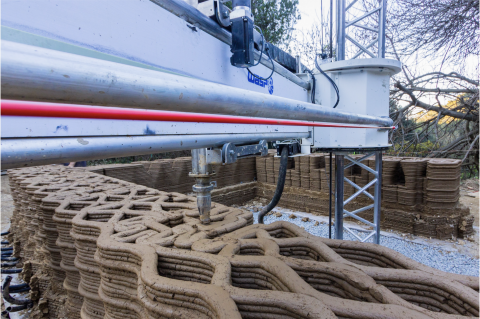TOVA

The Institute for Advanced Architecture of Catalonia (IAAC) presents its first building made with earth and a 3D printer, a valuable addition to the recent emergence of a multitude of 3d printed building solutions around the world. The project results from the ongoing research conducted by IAAC towards 3D printing architecture with an aim to develop realistic architectural solutions that use additive manufacturing to provide sustainable, affordable and community-based processes of housing construction.
The construction has been carried out at the Valldaura Labs facilities, in the natural park of Collseolla, in the outskirts of Barcelona. The prototype, completed with locally sourced earthen materials, certifies the potentials of 3d printing with sustainable materials, in response to the current climate challenges and housing emergencies. TOVA further demonstrates the relevance of implementing past craftsmanship techniques — vernacular earthen architecture — with those of the future — large scale 3D printing technology — in the contemporary built environment.
The project has been developed by the 3dPA postgraduate research programme at IAAC. The objective of this applied research programme is to train young architects and academics with the proper knowledge and tools in accordance with the future of construction and further explore the possibilities and potential of additive manufacturing in this sector.
In a context where the current construction methods are responsible for around 40 % of CO2 emissions, ‘TOVA’ stands out for being one of the most sustainable and environmentally friendly construction forms that can be applied today. This prototype is the beginning of a larger research project in collaboration with WASP, which will result in the construction of a complete 3d printed house with earthen materials.


Mission
LARGE SCALE 3D PRINTING
EARTH
CIRCULAR CONSTRUCTION
ADVANCED MATERIALS
LOW CARBON EMISSIONS
The design and implementation of the TOVA project was done within the 3D Printing in Architecture postgraduate programme of the Institute for Advanced Architecture of Catalonia. The project reflected a wide range of disciplines and knowledge fields, including architecture, construction methods, material science, robotics, computational design, structural analysis and climate engineering. In line with the schools’ architectural practice, the construction methods are based on those of earth construction in Vernacular architecture. Through material science, individuals are provided with advanced knowledge on earth as a construction material ensuring the quality of the project and its stand as a sustainable habitat. The use of robotics and computational design are crucial in the design and implementation of the project. 3D printing technology allows for a precise, waste free and efficient construction, while computational design tools help optimise the design for structural stability and energy efficiency according to precise and varying environmental data sets.
The integration of computational design tools in the project allows for an adaptable construction, optimised in terms of design and energetic efficiency in direct accordance with its environment. This performance is informed by the monitoring of the prototype’s ability in withstanding the test of time which will benefit on-going international research on the topics.
For indirect beneficiaries, the project serves as a showcase for the potential of 3D printing in architecture to promote new construction practices, inspiring the wider industry to embrace long-term, life-cycle thinking through endless applications in the built environment; from homes, to public spaces, interiors and exteriors. In combination with other construction systems, it can accommodate complex and innovative building models which would significantly reduce the environmental impact that construction currently entails.
Technical factsheet
- Funded Private
- NEB Value Sustainability, aesthetics
- Location Barcelona, Spain, Spain
- Application category Building | Innovation
- Related Technical Working Group Community and Sustainability